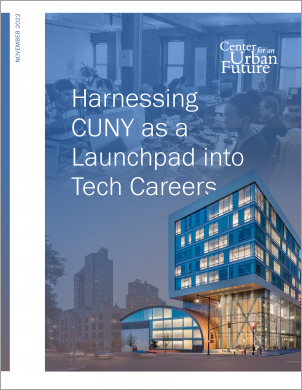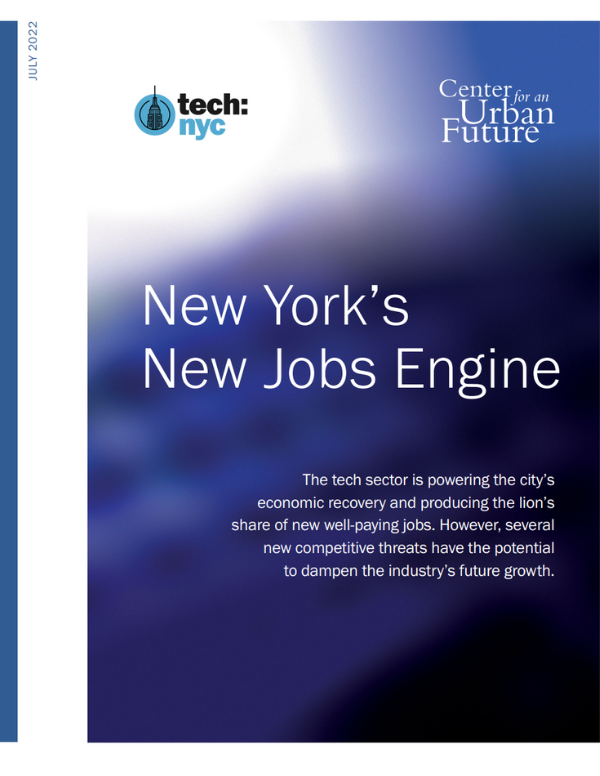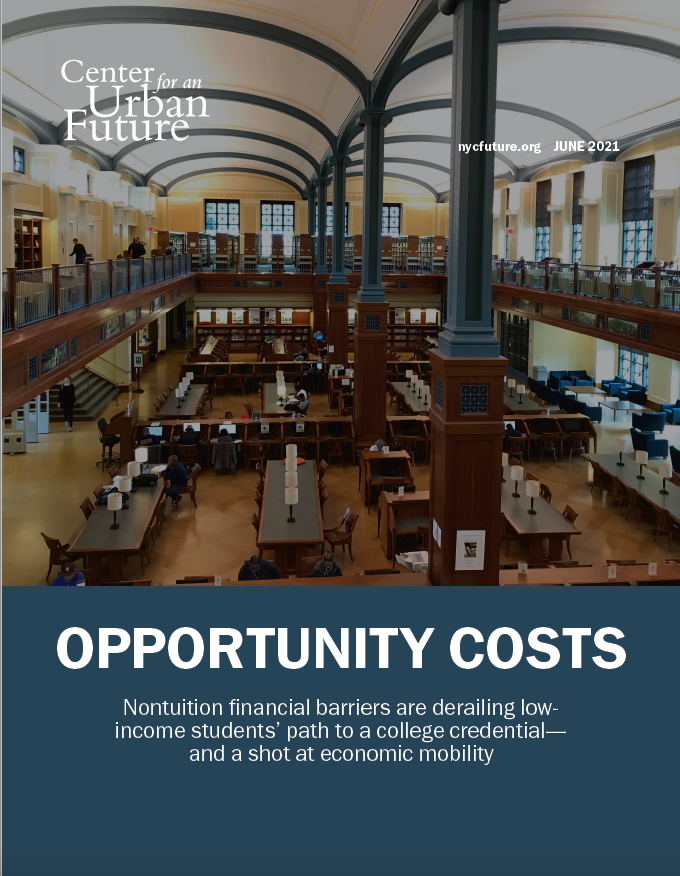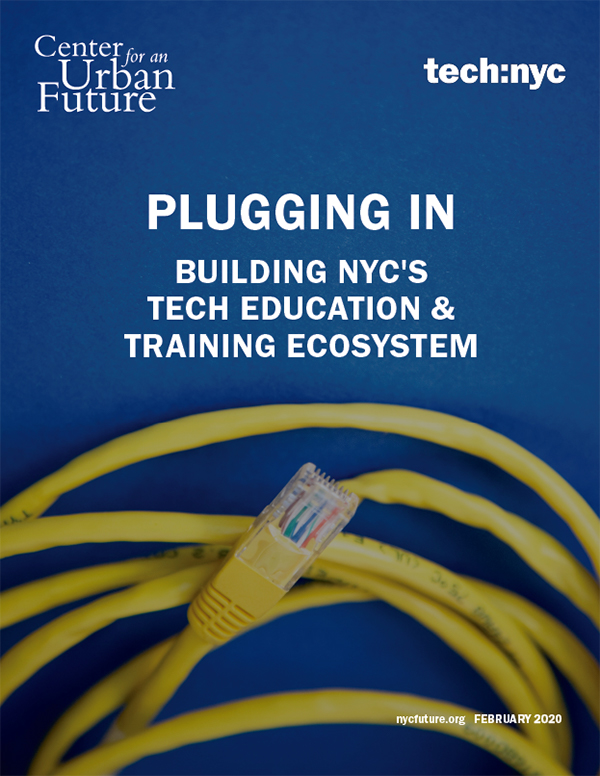New York City's fast-growing tech sector has become the city's most consistent source of new middle- and high-wage jobs. But even as demand for tech talent surges, New Yorkers of color remain strikingly underrepresented among the city’s tech workforce. As city leaders consider options for expanding access to the well-paying jobs powering the city’s economic future, there is no institution better positioned to accelerate these efforts than the City University of New York (CUNY).
Although the city is home to a number of well-regarded nonprofit tech training programs, only CUNY has the capacity to help New Yorkers from underrepresented populations prepare for technology careers at scale. Training providers such as Per Scholas, Pursuit, and The Knowledge House serve anywhere from a few dozen to a few hundred New Yorkers each year—meeting only a fraction of the opportunity that exists today to expand access to the tech sector. By comparison, CUNY graduates more than 9,000 students annually with science, technology, engineering, and math (STEM) degrees, including nearly 4,000 students with technology degrees.1 Among all CUNY students enrolled in STEM programs, approximately half are Black and/or Hispanic, and roughly 71 percent of all CUNY students come from households earning less than $40,000 per year.2
Unfortunately, New York has only begun to harness CUNY’s remarkable potential to serve as the city’s largest and most equitable springboard into technology careers.
Today, most tech companies in the city employ few if any CUNY grads. An analysis of data from the social networking site LinkedIn shows that fewer than 0.3 percent of the employees of the city’s largest technology firms are affiliated with CUNY—a smaller share than other New York colleges including Columbia and NYU, and other public universities such as the University of Washington and the University of Texas at Austin.3 At the same time, only a handful of tech companies actively recruit for entry-level positions from CUNY campuses. And although CUNY produces more undergraduate students with computer science degrees than any other university in New York City, they find themselves in fierce competition for a limited supply of internships. Just 10 percent of all CUNY students report participating in a paid internship during their college careers—an especially serious problem among graduates interested in entering the tech sector, where internships are considered vital on-ramps to full-time technology jobs.4
While New York City has launched some successful programs that have helped grow the number of CUNY graduates in computer science and related fields, these initiatives still serve only a fraction of the students who could benefit from them. For example, the CUNY Tech Prep program serves just 170 students each year. The $20 million CUNY 2X Tech initiative has only reached 7 of 25 colleges, with no community colleges served to date. And while CUNY students who participate in the city’s Tech Talent Pipeline (TTP) Residency internship program are more than three times as likely to secure a full-time job after graduation compared to their peers, the program has only served about 750 students over the past five years.5 Compounding these capacity challenges, our research finds that most CUNY colleges have no more than two or three career counselors per 10,000 students.6
By strengthening CUNY’s role as a springboard into tech careers, Mayor Eric Adams and the New York City Council can significantly expand access to the well-paying jobs driving the city’s economic recovery— and lay the foundation for a more equitable economy in the future.
This report provides analysis about what more is needed—from CUNY, from the city’s tech employers, and from city and state policymakers—to expand access to technology careers for CUNY students. Made possible with support from Amazon, the report builds on CUF’s long track record of research around opportunities to expand access to tech careers, from the first study to map the city’s tech training and education ecosystem to several data briefs about the need to upskill New York’s workforce in anticipation of a more automated economy. CUF has also published several studies about CUNY, including a 2021 report that detailed CUNY’s vital role as a springboard to the middle class.
This new report details the barriers that prevented larger numbers of CUNY graduates from breaking into the technology sector, showcases programs at CUNY and elsewhere that are working, and advances more than a dozen achievable policy recommendations to ensure that far more CUNY graduates are able to access well-paying tech careers. The study was informed by extensive data analysis and draws on more than 75 interviews with CUNY officials—including college presidents, administrators, faculty, and career advisors—as well as decisionmakers from technology companies, including HR officials and company executives; leaders of nonprofits focused on expanding pathways into the tech sector; and more than 20 current and former CUNY students pursuing technology careers.
Over the past two decades, New York City’s tech sector has become arguably the city’s most reliable source of new, well-paying jobs—and continues to drive job growth during the pandemic. Since 2010, the city’s tech sector has added 113,900 jobs, a growth rate of 142 percent, accounting for a remarkable 17 percent of the city’s entire private sector job growth during this period. Even as the city’s economy plunged following the onset of the pandemic in early 2020, the city’s tech firms continued hiring. While most other parts of the city’s economy have yet to rebound to their pre-pandemic employment levels, employment in the city’s tech sector is up 17.5 percent since 2019, outpacing all other industries.7
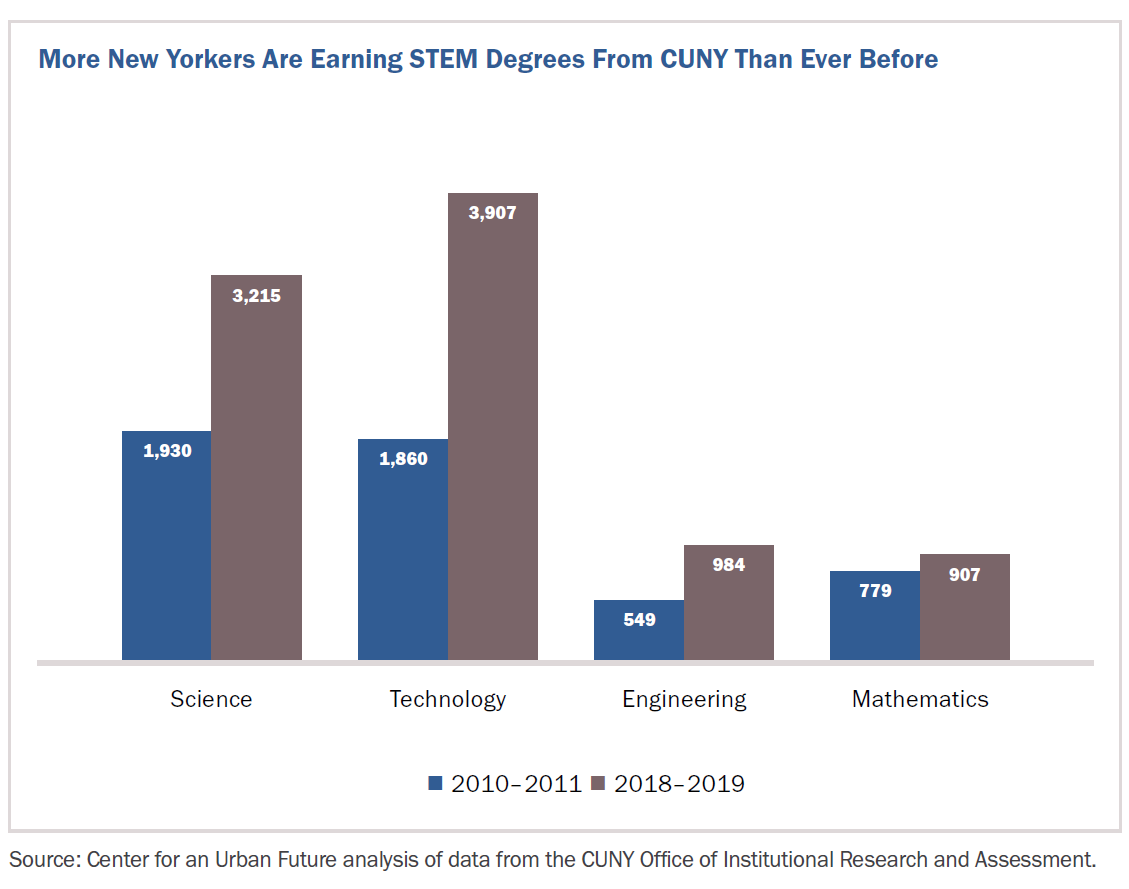
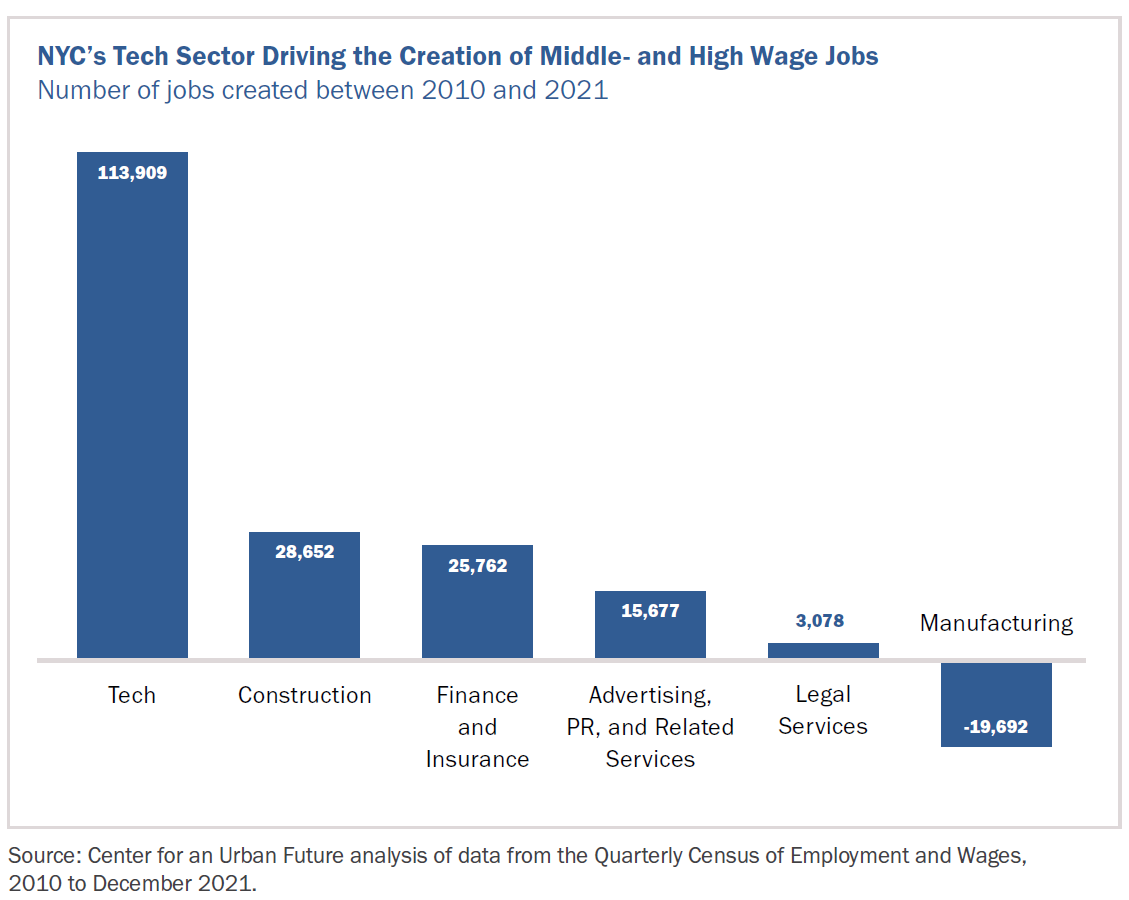
But while jobs in technology represent a large and growing opportunity for New Yorkers, the city’s tech sector still falls far short of reflecting the diversity of the city. Black and Hispanic New Yorkers make up 43 percent of the city’s overall workforce, but account for just 20.8 percent of those employed in the tech sector.8
If city leaders are to succeed in tackling these disparities—and building stronger and more equitable pathways into the city’s roaring tech economy—then CUNY will have to be a centerpiece of the strategy. As just one example of the university’s potential, CUNY colleges graduated more Black and Hispanic students with technology degrees in 2019 (1,741) than Columbia University granted total undergraduate degrees in 2021 (1,044).
The problem is that while the number of CUNY students earning technology degrees has surged over the past decade—from 1,597 in 2010 to 3,907 in 2019, a 145 percent increase—graduates are still struggling to get hired and advance into the sector’s well-paying career paths.
“Our campus looks like the future of [the tech sector’s] workforce and its customers,” says Thomas Isekenegbe, president of Bronx Community College. “But our students are not well represented in New York’s tech companies today.”
Leaders across the CUNY system express a similar sentiment: too few CUNY graduates are securing jobs in the city’s high-flying tech sector after graduation, even as a growing number of students are pursuing technology degrees and credentials.
“The technology sector needs to recognize that there’s a goldmine in these campuses,” says Vince Boudreau, president of City College. “But it takes getting in the door. If employers are window-shopping for students, they often walk past our window.”
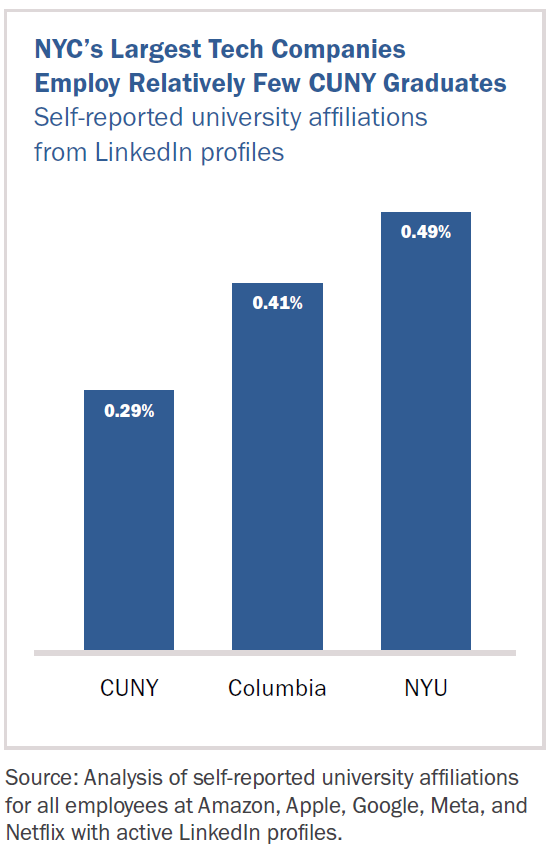
Indeed, the Center for an Urban Future’s analysis of publicly available data on employment and earnings reveals that computer science and other technology degrees are not always translating into career success for many CUNY graduates. In many cases, CUNY graduates are securing jobs in lower paying positions like technical support or software quality assurance—rather than software engineering—which leads to striking earnings disparities. For instance, the median CUNY graduate with a bachelor’s degree in computer science earned just $45,834 one year after graduation—31 percent less than the $66,240 earned by the average entry-level worker in a computer occupation in New York City. Five years after graduation, the earnings gap is even wider, with the median CUNY computer science graduate earning $69,849—37 percent less than the $111,130 median wage for all computer occupations workers in NYC.9
In other cases, CUNY graduates are struggling to break into the tech sector in the first place. According to CUF’s analysis of data from labor market analytics firm Lightcast, only 50 percent of all CUNY computer science graduates from 2017 to 2021 were employed within their field of study one year after graduation.10 CUF’s analysis of data from the U.S. Census Bureau shows that about one in seven—or 13.9 percent of—CUNY computer science graduates is working in the retail or food service industries one year after graduation. Among community college graduates with computer science degrees, the share in retail or food service is 15.2 percent. At City Tech, it’s 18.1 percent. By comparison, just 16.7 percent of City Tech’s computer science graduates are working in professional, scientific, and technical services occupations.11
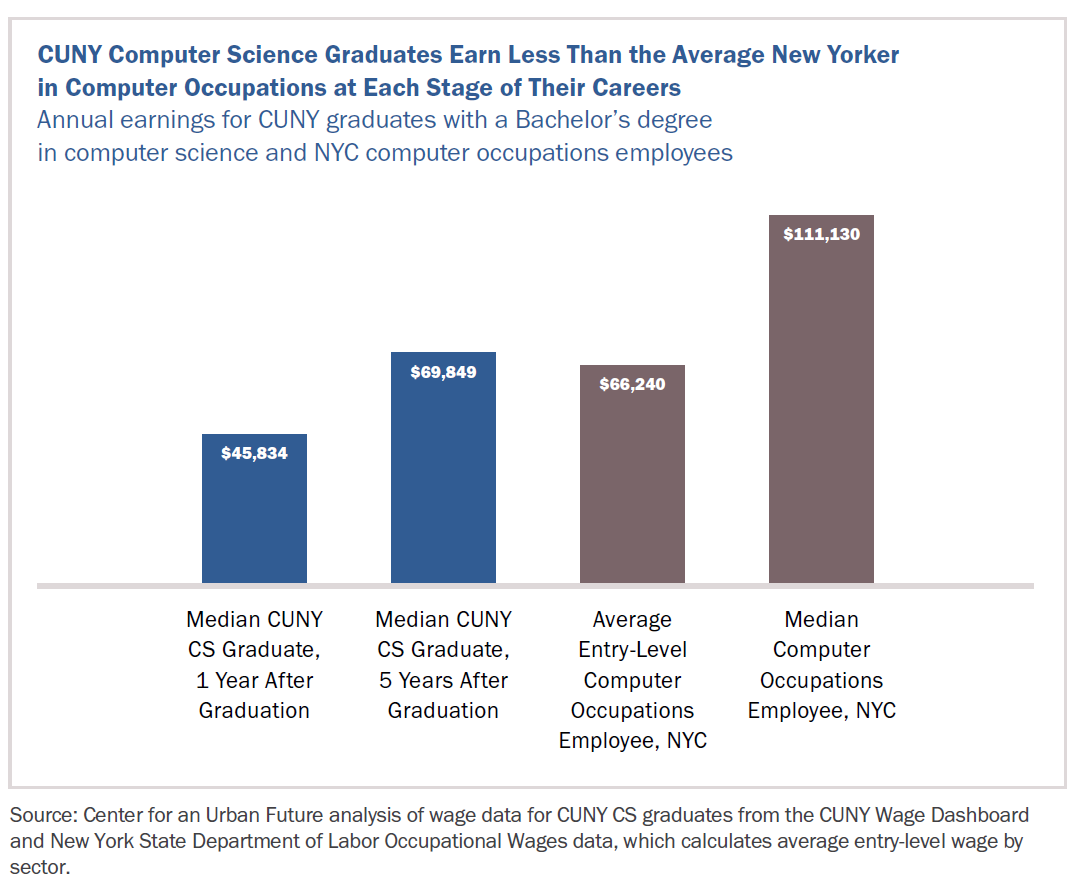
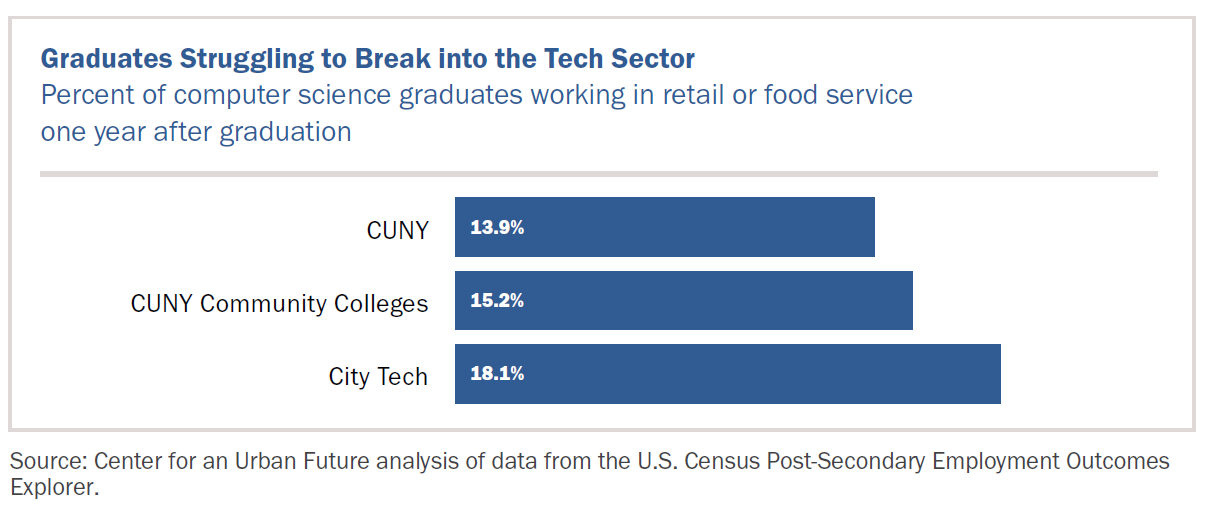
Despite these challenges, some large tech companies, including Amazon and Google, have taken significant steps to recruit from and partner with CUNY in recent years, leading to an increase in the number of CUNY students landing internships and jobs. In March 2022, Amazon and CUNY announced a partnership as part of CUNY’s Career Success Initiative, which helps New Yorkers launch and grow careers in partnership with employers. Amazon provides tuition for hourly employees to pursue degrees at eight CUNY colleges. Google, likewise, has developed new programs together with CUNY, including recruiting from CUNY colleges, partnering with Borough of Manhattan Community College to train tech apprentices, and investing in career readiness training.
“We have thousands and thousands of entry-level tech jobs and I anticipate that growing,” says Derrick Bates, early career recruiting leader for Amazon Web Services. “When I look at the 25 CUNY schools, I see such an opportunity to expand on. Corralling the schools is hard. But with a central point of contact, we could build something really dynamic here.”
These initiatives, however, are still the exception rather than the norm among tech firms in New York City. Across interviews with more than a dozen tech sector leaders familiar with their employees’ educational backgrounds—including startup founders and CEOs, software engineers at large and mid-sized tech firms, campus recruiters for tech giants, and hiring managers representing a wide range of companies with tech-talent needs—most reported having no CUNY graduates currently employed in tech roles or could only identify one or two. Even at companies that are focused on diversity and inclusion, or that have expanded hiring of candidates from non-traditional backgrounds, CUNY graduates are underrepresented in their ranks when compared to students from other public colleges or private universities.
“There are two CUNY graduates working at our company last time I checked—I’m one of them, the other was a person I recommended,” says a software developer in the New York City office of a global tech company, who requested anonymity in order to speak candidly. “I’m the only one,” says another CUNY graduate working as an engineer for a mid-sized tech company headquartered in New York City. Interviews suggest it’s the same at companies that began as startups in New York City during the past two decades and have since expanded. “We haven’t made a single new grad offer to anyone coming in from CUNY,” says an engineering director at one such mid-sized firm.
Obstacles to Unlocking CUNY’s Full Potential as a Springboard into Tech Careers
Even after a decade of steady progress, several challenges prevent CUNY from achieving its full potential as a launchpad into tech careers. Although New York City has launched several new initiatives in recent years designed to strengthen CUNY’s role as an incubator of tech talent, these programs are still operating at too small a scale. Insufficient investment in career services means that few students have support navigating the job market and connecting with potential employers in advance of graduation. Far too few CUNY students are obtaining paid internships, seriously limiting employment prospects after earning a degree. Meanwhile, employers struggle to find a clear entry point into the CUNY system, driving all but the most well-resourced and determined to seek out partnerships elsewhere.
Promising city-funded initiatives are still too small-scale.
In recent years, New York City has made important new investments intended to boost the number of CUNY students earning technology degrees and help more students break into tech sector careers. This report finds that these efforts are showing results but remain too small scale and still serve just a fraction of the students who could benefit from them.
For instance, beginning in 2017, the city invested $20 million in CUNY 2X Tech, an effort to double the number of CUNY students graduating with tech-related degrees by 2022 while expanding access to industry-informed instruction and advising. But while the program has succeeded in boosting the number of technology graduates, our analysis of data on the initial five years of the program finds significant room to grow.
As of 2022, CUNY 2X Tech has only reached 7 of 25 CUNY colleges; the list includes no community colleges and leaves out City Tech, the college with the largest number of technology students in the system. In total, CUNY 2X Tech is providing enhanced programs to just 4,962 out of more than 23,000 technology majors across the university—approximately 21 percent.
Other crucial CUNY programs are significantly smaller in scale. The well-regarded CUNY Tech Prep program is opening doors to tech careers, with 75 percent of program participants landing a job or internship within five months of completing the program. But it serves just 170 students annually—less than 1 percent of all CUNY students pursuing technology degrees. Likewise, while students who go through the city’s Tech Talent Pipeline Residency internship program are more than three times as likely to land a job when they graduate compared to their peers, the program’s capacity has been limited to just 150 students per year across three colleges. Additionally, students who take a course taught by an industry professional through the Tech-in-Residence Corps are more than two times as likely to land a job when they graduate compared to their peers, but this program reaches only about 500 students per semester.
More investment is needed to expand and strengthen career services and build relationships with the tech sector.
Across interviews with professors, career advisors, and administrative leaders on multiple CUNY campuses, our research finds that a ratio of 2 to 3 career services counselors per 10,000 students is common. City Tech has just three career advisors serving approximately 17,000 students, each with office hours just two days per week.
This leaves CUNY woefully understaffed for the level of career counseling and employer engagement that could significantly expand work-based learning opportunities and improve post-graduation employment outcomes.
Perhaps because of this staffing shortfall—as well as a lack of career support tailored to technology and other in-demand fields—few students are taking advantage of resources that are available. Only about 25 percent of students make use of existing career services during their college careers, according to current and former CUNY faculty and administration officials and survey data, and they tend to be students who are already among the top performers.
“CUNY says it cares about career services, but it doesn’t sufficiently fund it,” says one senior university official who requested anonymity. “There is not an adequate investment in work-based learning, internships, and the business development roles focused on building and managing employer partnerships. And faculty just don’t have time to take this on independently.”
Far too few CUNY students are able to access paid internships, limiting job prospects after graduation.
For most college students aspiring to a career in tech, an internship in the industry is an essential prerequisite for employment after graduation. However, just 10 percent of CUNY students say they have held a paid internship at any point during their time at CUNY and only 21 percent report participating in an internship of any kind. Fully 34 percent of CUNY students surveyed say they never received information about internship opportunities and 61 percent say they did not have time to participate.
For students pursuing degrees in computer science and related internships in highly competitive tech fields, the odds are even slimmer. Data from Lightcast shows that of the 13,647 total internship postings nationwide seeking computer science majors, only 709 were in the New York City metro area, of which just 398 were posted in the city itself. Moreover, an average of 175 candidates applied for each internship in New York City, compared to just 5 candidates per internship nationwide.
“An internship at a bigger tech company is typically a 3-month tryout where you’re working on a project for 12 weeks, and that’s pretty much what the actual full-time job is,” says a talent recruiter focused on university programs for a large tech company, who requested anonymity to speak openly about his experiences with CUNY. “Having an internship is absolutely the best experience you could have in terms of getting a full-time job.”
CUNY is challenging for employers to navigate.
Nearly all of the tech sector recruiters and hiring managers interviewed for this report say that they have either struggled to work directly with CUNY or have been dissuaded from reaching out due to the complexity of the system and the lack of employer support.
Many simply don’t know how to approach a system with 25 separate career services offices and no one single point of contact for employers. These challenges are exacerbated by a lack of dedicated employer relations specialists focused on working with companies. Our research finds that most CUNY colleges rely on the director of the campus career services center to facilitate all employer engagement, leaving very little bandwidth to proactively reach out to prospective partners.
For enterprising employers willing to explore campus-by-campus opportunities, options are generally limited to posting jobs to online bulletin boards and participating in annual or biannual career fairs. Additional employer services are few and vary widely across campuses; for instance, while LaGuardia Community College offers employers options to table on campus, conduct on-campus interviews, and organize field trips for students to visit workplaces, Medgar Evers lists no information for prospective employers on the college’s official career services website. By comparison, NYU offers dozens of employer engagement services ranging from social media takeovers, industry meetups, and on-campus coffee chats to university-wide branding, sponsorship of career hubs and hackathons, and tailored support from a dedicated relationship manager.
“Getting help setting up recruitment events at CUNY is difficult,” says an experienced recruiter for a New York-based tech company who asked to remain anonymous in order to speak candidly. “It’s hard to even get in front of students.”
CUNY is struggling to hire enough faculty to keep pace with demand for computer science and tech programs—and the needs of a fast-changing industry.
Although interest in computer science and other tech programs is surging across CUNY, staffing shortages are preventing some programs from meeting this demand. Unable to afford more full-time faculty, department leaders are scrambling to hire adjuncts and converting courses that were formerly taught as seminars into large lectures, according to interviews with CUNY faculty, advisors, and administrators.
For example, 10 years ago, Queens College was home to 406 computer science majors and 20 faculty. Now, the college has more than 3,500 majors and just 15 tenure-track faculty, according to administrators with first-hand knowledge of the department. Likewise, Hunter College has gone from 85 computer science majors 12 years ago to more than 1,600 today, while only adding 13 new faculty, which has resulted in the conversion of every required computer science course into a large lecture with at least 150 students.
“The lack of faculty for computer science is a problem,” says one CUNY department chair, who requested anonymity as he is not authorized to speak publicly about these challenges. “A few colleges have added faculty, but it’s not enough. All the colleges have the same problem.”
CUNY colleges face challenges hiring and retaining faculty with up-to-date industry knowledge in part because industry salaries far exceed what CUNY is able to pay. Several CUNY students interviewed for this report say that the practical knowledge they were exposed to was too often out of date. “They’re not really keeping up with the latest trends, the latest languages, and really the latest technologies,” adds a recent graduate of Hunter College.
“We have about 200-plus students in the cybersecurity program,” says President Isekenegbe of Bronx Community College. “The problem is hiring the faculty. You can make $100,000-plus in industry, but we can only pay $65,000.”
Few tech employers have embraced recruiting and hiring from CUNY.
Although a small but growing number of employers in the city’s tech sector have embraced CUNY in recent years, too few tech firms have made it a priority to recruit and hire from CUNY. Many firms, especially those among the city’s fast-growing ranks of small and mid-sized start-ups, continue to hire through personal referrals from current staff and direct outreach to a small number of highly selective colleges, leading to predictably similar results.
Even as some companies place new emphasis on hiring goals around diversity and inclusion, hiring managers and CUNY advisors say that firms often end up competing for a small pool of diverse talent emerging from the same well-known colleges and universities, rather than tapping into CUNY.
The problem is evident at nearly any CUNY campus. Tech firms typically account for just 1 or 2 out of 100 or more companies that participate in on-campus career fairs. Tech internships marketed to CUNY students are in very short supply and students say they are far more likely to see job postings for tech roles in government, healthcare organizations, or financial services firms than in the tech sector. Even as firms across the tech sector race to keep pace with hiring needs, a recent survey of tech executives in New York found that just 24 percent say they are even considering CUNY to help meet their hiring needs.12
“We have two career fairs a year with dozens of presenters from different industries,” says one CUNY career advisor who asked to speak anonymously. “But almost no tech companies attend.”
The Path Forward
New York City’s booming tech sector is producing more well-paying jobs than any other part of the city’s economy and is poised for significant future growth. But while employer demand for tech talent has continued to escalate, New Yorkers of color and those from low-income backgrounds remain seriously underrepresented in the tech workforce. Building a more equitable economy for the long-term will require changing this dynamic, and CUNY is uniquely positioned as an engine of change. But little progress will be possible without a new level of investment focused on boosting career success, in addition to significant policy changes within the CUNY system, city and state government, and among employers in the tech sector.
City leaders, employers, and CUNY should all take bold steps to broaden access to the thousands of good jobs expected to come online in the coming months and years.
To achieve this goal, Mayor Eric Adams and City Council should prioritize new investment in CUNY focused not only on boosting the number of technology graduates, but on greatly expanding initiatives that lead to postgraduate career success. Mayor Adams should set a goal of doubling the number of technology graduates from underrepresented backgrounds over the next five years and invest $10 million in scaling up successful programs that are otherwise in danger of coming to an end—including CUNY 2X Tech, CUNY Tech Prep, and the Tech in Residence Corps—while expanding these initiatives to other senior and community colleges.
City and state officials should also collaborate to create new programs aimed at tackling the most persistent barriers CUNY students face to career success, including a major new initiative to boost the number of paid internships available in the tech sector; new resources for strengthening and expanding career services and employer relations at every CUNY college; and new investment to hire full-time computer science and technology program faculty, especially those with industry experience and knowledge in high-demand fields like cybersecurity, artificial intelligence, and cloud computing.
Equipped with these additional resources, CUNY should commit to new efforts focused on boosting career success in technology fields and making the university a much more approachable partner to employers in the private sector. To that end, CUNY should prioritize the hiring of career services staff with tech industry expertise and employer relations specialists who can forge connections with recruiters and hiring managers. CUNY should also work to develop a single point of entry for employers interested in partnering with CUNY and expand the services offered to those employers beyond online job postings and occasional career fairs. CUNY leaders should partner with tech firms and the city’s tech industry association to launch a new fellowship program that would embed faculty in industry for short-term professional development sprints, and create a flagship Tech Careers Hub—modeled on a similar initiative in San Diego—which would boost the visibility of tech firms on campus.
These efforts will only prove successful if employers in the technology sector step up, too. Tech firms should commit to offering far more paid internships—including spring and fall sessions and microinternships—and work with CUNY on university specific internship and fellowship programs. Tech leaders should make CUNY a centerpiece of early-career recruiting efforts; develop partnerships with CUNY’s computer science and technology departments by joining advisory boards, working directly with campus career centers, and hosting both on-campus and offsite hackathons, workshops, networking events, and other activities where CUNY students can engage with industry professionals at each stage of their college careers. Lastly, tech employers should partner with city leaders and CUNY to launch a CUNY Tech Alumni Network, leveraging the small but growing number of CUNY graduates employed in the city’s tech sector to help market CUNY students to tech companies and build support systems within the industry.
There is no one simple solution for fully leveraging CUNY as a springboard into technology careers, but the potential is nearly limitless. This report makes the case that CUNY should be the centerpiece of the city’s effort to expand access to technology jobs, analyzes the challenges preventing more CUNY students and alumni from finding career success in technology fields, and outlines the ways city and state government, technology employers, and CUNY itself can build on and go beyond the most successful initiatives of recent years to develop a tech workforce that better reflects the diversity, talent, and determination of New Yorkers across all five boroughs.
Endnotes
1. “Ten-Year Trends in Degrees Granted in Science, Technology, Engineering, and Math (STEM) Disciplines,” CUNY Office of Institutional Research and Assessment, June 16, 2020, https://www.cuny.edu/wp-content/uploads/sites/4/page-assets/about/administration/offices/oira/institutional/data/current-student-data-book-by-subject/STEM_deg_trends_ay18-19_final_rev.pdf
2. Data about the race/ethnicity of CUNY students in STEM programs is from “Enrollment in STEM Disciplines by Race/Ethnicity,” by the CUNY Office of Institutional Research and Assessment. Data about household income for those students is from the CUNY 2016 Student Experience Survey.
3. Center for an Urban Future analysis of publicly available data from LinkedIn.
4. “2018 Student Experience Survey,” CUNY Office of Institutional Research and Assessment, February 6, 2020, https://public.tableau.com/app/profile/oira.cuny/viz/2018StudentExperienceSurvey/CoverPage
5. Center for an Urban Future interviews with officials at NYC Tech Talent Pipeline and CUNY.
6. Center for an Urban Future analysis of data collected from CUNY college websites and through interviews with career services staff.
7. Center for an Urban Future analysis of data from the Bureau of Labor Statistics Quarterly Census of Employment and Wages. This analysis uses the Federal Reserve Bank of New York’s narrow definition for measuring employment in the tech sector—one that doesn’t include tens of thousands of additional tech workers employed at banks, hospitals, and in other non-tech industries.
8. To examine the racial/ethnic composition of the city’s tech sector, CUF analyzed 17 tech-specific occupations, such as database administrators, web developers, and computer network architects, using data from the 2019 American Community Survey.
9. Data on earnings for CUNY graduates is from the CUNY Wage Dashboard. Data on median occupational wages is from the New York State Department of Labor.
10. Center for an Urban Future analysis of data from Lightcast.
11. Center for an Urban Future analysis of data from the U.S. Census Post-Secondary Employment Outcomes Explorer.
12. “Tech Hiring Trends,” Accenture Research and Tech:NYC, May 2022, https://www.accenture.com/content/dam/accenture/final/industry/high-tech/document/Accenture-research.pdf#zoom=40


